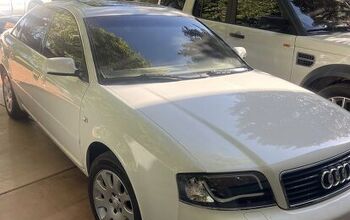Capsule Review: 2008 Renault Twingo Quickshift Elettrica

Car manufacturers are toast! At least, that’s what members of the Electric Vehicle (EV) religion believe. A car maker’s core business is engines—but engines are over, they say. It’s 1910 all over again, and internal-combustion cars are going the way of the horse-drawn carriage. But I say: Wrong! The electric Twingo I drove proves that there is more to making a good drive than just getting the propulsion stuff right.
As previously reported, the Th!ink EV was a disappointment: feckless, lightweight-feeling, stiff-legged, wobbly. A real let-down when you consider that it was specifically designed for the requirements of electric power. So it was with some skepticism that I took the helm of a Renault Twingo that MES-DEA (a Swiss company) had turned into an EV.
It has the same quaint-yet-effective Zebra battery system as does the Nordic Th!ink. To freshen up your memory, the molten-salt-based Zebra system is about 70% as energy-dense as Lithium-Ion batteries. Mercedes was involved in Zebra technology for about a decade for three reasons: simplicity, recyclability and a lower price. Mercedes says they quit Zebra because of the sodium battery’s requirement to be kept at a high temperature. EV-insiders claim corporate politics that led to Zebra’s abandonment. Be it as it may, MES-DEA is delivering EV Th!nks, Twingos and Fiat Pandas to customers in Switzerland and Italy on a daily basis.
The problem I had with the Th!nk was not with the electric system, but with the car. The modified Twingo feels just fine. You get in, turn the key, put the direction selector in gear, and set off. Strong, torquey acceleration is accompanied by an unobtrusive electric-motor whine. Steering is synthetic (as in all first-generation Twingos). Through urban Zurich, the Renault EV handled bumps quite well, albeit feeling heavier than a normal small car.
Unlike the Th!ink: the Twingo seems properly screwed together, with no creaks or buzzes to be heard. It felt like a solid, effective, well-made car—which may have something to do with the fact that the Twingo had a production run of 13 years before MES-DEA breathed their electrons upon it.
In fact, the Renault Twingo sold in almost 2.4 million units during its run. It was a versatile little car that had exceptional interor space due to a sliding rear seat and a micro-van layout. The electric version does without the sliding seats but still has plenty space for four, plus acceptable luggage.
I tested the Twingo in conjuction with a seminar held by a Swiss electric utility. For utility companies, electric cars are the equivalent of sildenafil citrate, and this particular utility (EKZ of Zurich) has 30 Twingo Elettricas in its fleet. The company’s CEO has been driving one for six months on a daily basis, to be able to understand the pros and cons of EVs.
After 4,000 problem-free kilometers, he claimed the 150 km range was more than sufficient, his kids loved to be passengers, he was glad there was no space for his mother in law and the in-town acceleration was enough to humble sports cars.
On the negative side, the Twingo’s uphill top speed of about 55 mph—too slow for Swiss freeways (the normal top speed of 75 mph was only possible on flat roads). Nevertheless, “fun driving” was claimed. Fuel costs were super low ($1.66 per 100 km). For an inhabitant of a posh neighborhood, the ability to glide silently in and out of his garage at all times of the day was a real advantage.
Hearing all this from a conservative and affluent-looking Swiss CEO gave me reason to think this electric thing might yet have a bright future. And convinced me once again that EVs are like houses: it all comes down to location, location, location.

More by Martin Schwoerer
Latest Car Reviews
Read moreLatest Product Reviews
Read moreRecent Comments
- Master Baiter Mass adoption of EVs will require:[list=1][*]400 miles of legitimate range at 80 MPH at 100°F with the AC on, or at -10°F with the cabin heated to 72°F. [/*][*]Wide availability of 500+ kW fast chargers that are working and available even on busy holidays, along interstates where people drive on road trips. [/*][*]Wide availability of level 2 chargers at apartments and on-street in urban settings where people park on the street. [/*][*]Comparable purchase price to ICE vehicle. [/*][/list=1]
- Master Baiter Another bro-dozer soon to be terrorizing suburban streets near you...
- Wolfwagen NO. Im not looking to own an EV until:1. Charge times from 25% - 100% are equal to what it takes to fill up an ICE vehicle and 2. until the USA proves we have enough power supply so as not to risk the entire grid going down when millions of people come home from work and plug their vehicles in the middle of a heat wave with feel-like temps over 100.
- Kwik_Shift_Pro4X Where's the mpg?
- Grg These days, it is not only EVs that could be more affordable. All cars are becoming less affordable.When you look at the complexity of ICE cars vs EVs, you cannot help. but wonder if affordability will flip to EVs?


































Comments
Join the conversation
Robert, I understand your fears, but please note that the electric Smart FourTwos being tested with 100 units in London use Zebra batteries. Traffic in London ain't for pansies and if anybody gets fried, melted, incinerated or vaporized, I'm sure we'll hear about it pronto. Furthermore, a quick web check reveals reports that say things like "The Zebra system, particularly current pilot-line batteries, appears to present relatively low intrinsic risks during normal operation and from the minor mishaps that might be expected during such operation.", from "Current Status of Health and Safety Issues of Sodium/Metal Chloride (Zebra) Batteries", by David Trickett National Renewable Energy Laboratory.
I wrote the report referenced above. The technology (Sodium Nickel Metal Chloride (aka: Zebra) batteries) was both impressive and safe at the time. It appears only to have improved since then. I drive an '89 Suburban, a relatively new Honda Accord, and a '92 3/4 ton Dodge truck with the Cummins Turbo diesel (running on biodiesel most of the time) and can honestly say that given what I know and have seen (a few spectacular fatal accidents including the vehicles fully engulfed in flames) I'd much rather be in a vehicle with a breached zebra battery system than in any gasoline or diesel fueled unit with breached fuel tanks or lines. This includes my current vehicles. Without going into detail here, the zebra system is inherently safe because cell breaches tend to neutralize the sodium. The above made references to possible electrocution and other problems are perhaps well intentioned but are, frankly, uninformed. Interested readers can find the NREL report at: http://www.osti.gov/bridge/purl.cover.jsp?purl=/7101-0by8BY/native/ As for the vehicle itself, I have no experience or expertise regarding it. Also, for the record, I have no material or pecuniary interest in the zebra system. I am just glad to see that it has been commercialized since it appeared to me upon conclusion of my research to be a good midterm candidate for traction applications.